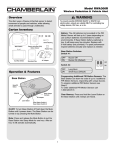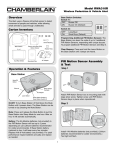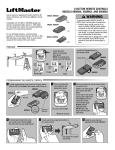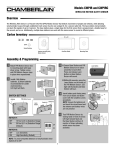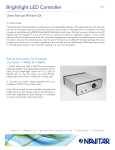Download Carton Inventory Operation & Features Overview
Transcript
Models CWA2000 & CWA2000C ® WIRELESS MOTION ALERT Overview The Wireless Motion Alert uses a Passive Infra-Red (PIR) Motion Sensor to detect movement of people and vehicles, while allowing small animals to pass through undetected. The Base Station is powered by the DC adapter and the 4 AA batteries supply power in case of a power outage. NOTE: The Base Station is intended for indoor use only. Carton Inventory Swivel Bushing Sun/Rain Shield Passive Infra-Red (PIR) Motion Sensor Base Station Mounting Plate DC Adapter (9 Vdc @ 200mA) Rubber Pads Operation & Features BASE STATION Batteries: If the DC adapter is not connected, the AA batteries in the Base Station should last up to one week. If the Base Station batteries are low, the Base Station will beep every 30 minutes. The AA batteries in the PIR Motion Sensor will last up to 2 years depending on use (lithium batteries are recommended for colder environments). If the PIR Motion Sensor batteries are low, the Base Station will beep every 30 minutes until the batteries are replaced. The PIR Motion Sensor will continue to operate with a low battery, however the light will not illuminate. For peak performance, inspect batteries annually and replace as needed. Antenna On/Off Button Volume Programming Additional PIR Motion Sensors: The Base Station can learn the code of up to 7 additional PIR Motion Sensors, responding with unique buzzes. To program additional PIR Motion Sensors see Step 4. To order additional PIR Motion Sensors call 1-800-528-9131. On/Off: To turn the Base Station on and off, hold down the power button until you hear the on/off tone. Volume: The Base Station is equipped with adjustable volume controls. The lowest volume setting is the mute feature. Clear Memory: Press and hold the Learn Button on the Base Station until 3 beeps are heard. 1 Assembly & Programming 1 2 4 Attach PIR Motion Sensor box to mounting plate with large silver screw. Tighten screw until PIR Motion Sensor stays in place when repositioned. B Within 60 seconds, press the Learn Button on the inside of the PIR Motion Sensor. LED light will illuminate and Base Station will buzz. Install 4 AA Alkaline batteries. (Lithium batteries recommended for colder environments.) LED light will flash. 5 Insert battery pack facing away from circuit board and fasten cover with the smallest screws (provided). NOTE: Ensure the batteries do not touch the circuit board and the antenna and battery wires are not pinched. 6 Test PIR Motion Sensor by waving hand in front of sensor. LED light should flash and the Base Station will buzz X number of times indicating which sensor has been activated. SWITCH SETTINGS PIR Motion Sensor Antenna A Ensure Base Station and PIR Motion Sensor are in close proximity to each other. Press and release Learn Button on Base Station. Buzzer will sound. Switch #1 Switch #2 Learn Button Learn Button Learn Button SWITCH #1: OFF ON 15 Feet (4.5 m) Detection Range 30 Feet (9.1 m) Detection Range (Default) PIR MOTION SENSOR INSTALLATION OFF 1 2 7 ON SWITCH #2: OFF ON Low Sensitivity High Sensitivity (Default) NOTE: To avoid unwanted detection of small animals move Switch #2 to OFF. 3 Plug in the Base Station. Adhere rubber pads to the bottom of the base. 4 AA batteries are optional in case of a power failure. DC Adapter Input Mount PIR Motion Sensor horizontally on solid surface 3-5 feet (1-1.5 m) off the ground and within 1/2 mile (0.8 km) of Base Station (rotate sensor to access screw holes). Unit should be able to swivel as needed. Attach sun/rain shield. NOTE: Keep PIR Motion Sensor antenna away from metal objects. Do not mount PIR Motion Sensor in direct sunlight, near moving tree branches, or in the path of a sprinkler system. Vehicle Alert Installation: For cars, the best mounting position is about 4 feet (1.2 m) high, between 10-20 feet (3-6 m) back, and angled to see the back of car after passing the sensor. OPTIONAL 10-20 feet (3-6 m) 4 feet (1.2 m) 2 Troubleshooting The PIR Motion Sensor lights up, but the Base Station does not respond. The PIR Motion Sensor must be programmed to Base Station (See Step 4). Ensure Base Station is on and the volume is turned up. Base Station beeps every 30 minutes. The batteries in the Base Station or the PIR Motion Sensor(s) are low. Replace the 4 AA batteries. Check the PIR Motion Sensor(s), if the LED illuminates on all of the PIR Motion Sensors, change the batteries in the Base Station. PIR Motion Sensor is detecting motion only part of the time. Ensure the PIR Motion Sensor is set to the High Sensitivity setting (See Step 2). To detect cars, it is best to mount PIR Motion Sensor at height of car’s motor and have it between 10-20 feet (3-6 m) from the road. Swivel sensor as needed. The Alert is not getting expected transmission range. Keep both antennas vertical and keep PIR Motion Sensor antenna away from trees and metal objects. Ensure Base Station is in clearest possible sight of the PIR Motion Sensor. The less objects between the devices, the longer the range. The Alert is giving false alarms. Check for moving tree branches or insects in sensor window. PIR Motion Sensor can also be triggered by light shining directly in sensor window, such as reflected sunlight, or motion in front of a light source. It is possible that condensation has built up on the sensor. Wipe condensation from PIR Motion Sensor with cotton swab. Let it sit inside for a few hours, open to the air, without the batteries and it should correct itself. Check Sensor Switches on PIR Motion Sensor. See Switch Settings. NOTE: The manufacturer is not responsible for any radio or TV interference caused by unauthorized modifications to this equipment. Changes or modifications not expressly approved by the manufacturer could void the user’s authority to operate the equipment. 3 NOTICE: To comply with FCC and or Industry Canada rules (IC), adjustment or modifications of this receiver and/or transmitter are prohibited, except for changing the code setting or replacing the battery. THERE ARE NO OTHER USER SERVICEABLE PARTS. Tested to Comply with FCC Standards FOR HOME OR OFFICE USE. Operation is subject to the following two conditions: (1) this device may not cause harmful interference, and (2) this device must accept any interference received, including interference that may cause undesired operation. FOR TECHNICAL SUPPORT DIAL OUR TOLL FREE NUMBER: 1-800-528-9131 www.chamberlain-DIY.com 114A3896E © 2011, The Chamberlain Group Inc. All Rights Reserved




